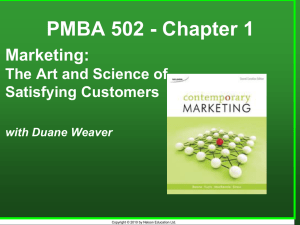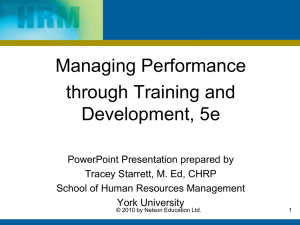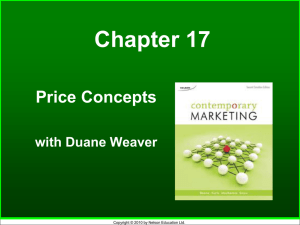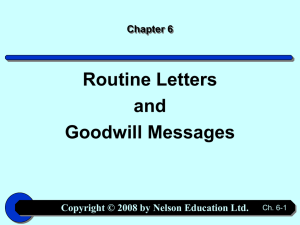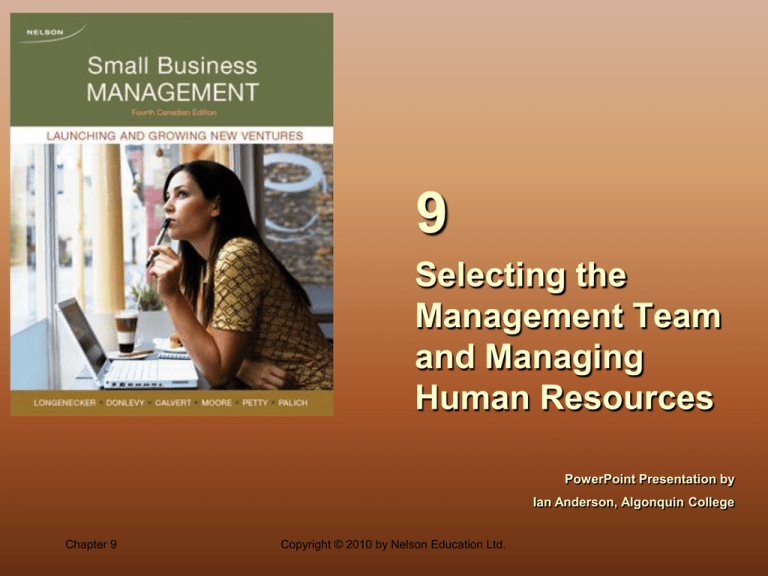
9
Selecting the
Management Team
and Managing
Human Resources
PowerPoint Presentation by
Ian Anderson, Algonquin College
Chapter 9
Copyright © 2010 by Nelson Education Ltd.
Looking Ahead
After studying this chapter, you should be able to:
1.
Discuss the entrepreneur’s leadership role.
2.
Discuss the evolving features of small firm management.
3.
Describe the characteristics and value of a strong
management team.
4.
Identify the various kinds of plans and approaches to
planning.
5.
Explain the importance of employee recruitment and list
some sources that can be useful for finding suitable
applicants.
Chapter 9
Copyright © 2010 by Nelson Education Ltd.
9-2
Looking Ahead
6. Identify the steps to take in evaluating job applicants.
Describe the role of training for both managerial and
nonmanagerial employees in a small firm.
8. Explain the various kinds of compensation plans and the
differences between daywork and incentives.
9. Describe the problem of time pressure and suggest
solutions
7.
10. Discuss the contract employees, labour unions, the
formalizing of human resources management, and
government regulations pertaining to employee
protection.
Chapter 9
Copyright © 2010 by Nelson Education Ltd.
9-3
Leading and Motivation
• Personal Involvement of the Entrepreneur
–Creates a significant personal relationship with
employees based on loyalty and respect.
–Directly influences employees’ understanding of
how the firm operates (e.g., its ethics).
–Makes the firm attractive to new employees.
Chapter 9
Copyright © 2010 by Nelson Education Ltd.
9-4
Leadership
• Leadership That Builds Enthusiasm
–Empowerment
• Giving employees authority to make decisions or take
actions on their own
–Work teams
• Groups of self-managed employees with the freedom to
function without close supervision
–Benefits
• Workers are more satisfied with their working environment
• Productivity and profitability are enhanced
Chapter 9
Copyright © 2010 by Nelson Education Ltd.
9-5
Constraints on Management
in Small Firms
• Small bank accounts and limited staff
• Lack specialized professional staff
– Market research, HR, Financial analysis, etc.
• Constant change in organizational and
managerial needs
Chapter 9
Copyright © 2010 by Nelson Education Ltd.
9-6
Stages of Growth
• One-Person Operation
• Player-Coach
– Entrepreneur begins coordinating the activities of
others
• Intermediate Supervision
– Entrepreneur no longer direct, hands-on management
• Formal Organization
– Greater formality in planning and control
Chapter 9
Copyright © 2010 by Nelson Education Ltd.
9-7
Stages of Growth
Exhibit 9-1
Chapter 9
Copyright © 2010 by Nelson Education Ltd.
9-8
The Management Team
• Management team:
– Consists of managers and other key persons who give a
company its general direction
• Characteristics of a Strong Management Team
– Capable of securing the resources needed to make
business a success
– Reassures investors about their investment and the
continuity of business
– Diversity of talent makes the team stronger than an
individual entrepreneur
Chapter 9
Copyright © 2010 by Nelson Education Ltd.
9-9
The Venture Team
• Founder(s)
–
–
–
–
–
–
Chapter 9
Advisory Board
Key Employees
Board of Directors
Management Team
Lawyer
Accountant
Copyright © 2010 by Nelson Education Ltd.
9-10
Complementary Management Team
• Building a Complementary Management team:
– Competencies required depends on type of business
• Combination of education and experience
• Requires achieving a balance of skills and competence in
functional areas
– Designing a management structure that defines
relationships and responsibilities
• Outside professional support:
– Supplements the skills of a management team
– Active board of directors can counsel and guide
Chapter 9
Copyright © 2010 by Nelson Education Ltd.
9-11
Planning
• Management Functions
– Planning
• Long-range – strategic plans (future)
• Short-range – operational plans (current year)
– Leading
– Organizing
– Controlling
Chapter 9
Copyright © 2010 by Nelson Education Ltd.
9-12
Planning Terminology
• Budget
– A document that expresses future plans in monetary terms
• Business Policies
– Guides for managerial decision making
• Procedures
– Specific methods followed in business activities
• Standard Operating Procedure
– An established work method of conducting a business activity
Chapter 9
Copyright © 2010 by Nelson Education Ltd.
9-13
Success in Planning
• Make time for planning
– Need detailed planning and quality control
• Set clear goals
– Goals - created for critical performance areas
– Objectives – short-term targets
• Encourage employee participation /
communication
Chapter 9
Copyright © 2010 by Nelson Education Ltd.
9-14
Recruiting Personnel
(The Importance of People)
• The Need for Quality Employees
–Employee performance affects the capability of the firm
to service customer needs.
–Employee performance affects profitability.
–Payroll costs affect firm’s bottom line.
–Quality of employees determines the long-term
competitive potential of the firm.
Chapter 9
Copyright © 2010 by Nelson Education Ltd.
9-15
Attracting Applicants to Small Firms
• Advantages of Employment in Small Firms
–Quicker movement to decision-making levels of
management
–Greater managerial freedom
–More opportunities for
broad-based managerial experience
–Flexibility in work scheduling
and job sharing
Chapter 9
Copyright © 2010 by Nelson Education Ltd.
9-16
Sources of Employees
Walk-ins
Executive Search
Firms
Internet
Recruiting
Schools
Employee Referrals
Help-Wanted
Advertising
Public Employment
Agencies
Private Employment
Agencies
Temporary Help
Agencies
Chapter 9
Copyright © 2010 by Nelson Education Ltd.
9-17
Job Description
• Job Description
–A written summary of the essential duties required by a
specific job
•
•
•
•
Aids in personnel recruitment.
Helps focus employees on their work.
Provides direction in training.
Serves as the basis for performance review.
• Job Specification
–A list of the skills and abilities needed by the job holder
to successfully perform a specific job
• Aids in selecting the most qualified job applicant.
Chapter 9
Copyright © 2010 by Nelson Education Ltd.
9-18
Job Description for a
Stock Clerk in Retail Food Store
Exhibit 9-6
Chapter 9
Copyright © 2010 by Nelson Education Ltd.
9-19
Evaluating Prospects and
Selecting Employees
Steps in Recruiting Employees
Application Forms
Applicant Interview
Reference Checking
Applicant Testing
Physical Examination
Chapter 9
Copyright © 2010 by Nelson Education Ltd.
9-20
Training and Developing Employees
• Purposes of Training and Development
– Prepare recruit to perform the duties of the job.
– Improve the performance of current employees.
– Prepare employees for career advancement.
– Improve morale of current employees.
– Serve as an inducement to potential applicants.
• Factors in Establishing a Training Program
– Determining the need for training
– Creating a plan for training
– Setting a timetable for training
– Providing employee counselling
Chapter 9
Copyright © 2010 by Nelson Education Ltd.
9-21
Types of Training and Development
Orientation of
New Personnel
Developing
Managerial and
Professional
Employees
Training&
Development
to Improve
Job Quality
Training to
Improve Quality
Training
Nonmanagerial
Employees
Chapter 9
Copyright © 2010 by Nelson Education Ltd.
9-22
Compensation and Incentives for
Small Business Employees
• Financial Incentives
–Keys to developing an
effective bonus plan:
• Set attainable goals.
• Set meaningful goals.
• Bring workers in
(employee participation).
• Keep targets moving.
• Aim carefully.
…continued
Chapter 9
Copyright © 2010 by Nelson Education Ltd.
9-23
Compensation and Incentives for
Small Business Employees
• Profit Sharing
– A percentage of profits is distributed to employees
• Fringe Benefits
– Supplements to compensation designed to be attractive and beneficial
to employees.
• Benefits are a substantial portion of payroll costs.
• Small firms tend to provide fewer benefits.
• Small firms are increasingly outsourcing the administration of
their benefits programs.
• Cafeteria plans can be a part of benefits along with dental care
and child-care re-imbursement
Chapter 9
Copyright © 2010 by Nelson Education Ltd.
9-24
Employee Stock Ownership Plans and
Profit Sharing
• Employee Stock Ownership Plans (ESOPs)
–Plans through which a firm is sold either in part
or in total to its employees.
• Employees’ performance is motivated by their sharing
of ownership in the firm.
• Owners can cash out and withdraw without selling to
outsiders.
• ESOPs offer tax advantages to owners and employees.
Chapter 9
Copyright © 2010 by Nelson Education Ltd.
9-25
Factors that Contribute to
Quality of Work Life
• Top six factors that employees felt “were
very important in a job”:
–A workplace free from harassment and discrimination
–A healthy and safe workplace
–Trustworthy senior management
–Good balance between work and personal/family life
–Good job security
–Good pay
Chapter 9
Copyright © 2010 by Nelson Education Ltd.
9-26
“Very Important” Job Factors
Exhibit 9-7
Source: CPRN-Ekos Changing Employment Relationships Survey 2000 (n 2000). Reprinted by permission of Canadian Policy
Research Networks Inc.
Chapter 9
Copyright © 2010 by Nelson Education Ltd.
9-27
Time Management
• The Problem of Time Pressure
–Many owner-managers work 60-80 hours per week.
–Effect of overwork is inefficient work performance.
• Time Savers for Busy Managers
–Effective use of time (time management)
•
•
•
•
•
•
Chapter 9
Analyze how time is normally spent
Eliminate practices that waste time
Carefully plan available time
Use a daily planner to prioritize activities
Don’t avoid unpleasant or difficult tasks
Limit conference and meeting times
Copyright © 2010 by Nelson Education Ltd.
9-28
Hours per Week Worked by
New Business Owners
Data developed and provided by the NFIB Foundation and sponsored by American Express Travel-Related Services
Company.
Chapter 9
Copyright © 2010 by Nelson Education Ltd.
Exhibit 9-8
9-29
Special Issues in HRM
• Contract Employees
–The “renting” of personnel from an organization
that handles paperwork and administers benefits for
those employees
• Leasing allows small firms to provide employee benefits.
• Leasing makes small firms subject to additional
government regulations.
–Professional Employment Organization
• A personnel-leasing company that places employees on
its own payroll and then “rents” them to employers on a
permanent basis.
…continued
Chapter 9
Copyright © 2010 by Nelson Education Ltd.
9-30
Special Issues in HRM
• Labour Unions
– Most entrepreneurs prefer to operate
independently and to avoid unionization
– Most small businesses are not unionized
– Unions primarily concentrate their efforts on
larger companies.
…continued
Chapter 9
Copyright © 2010 by Nelson Education Ltd.
9-31
Special Issues in HRM
• Formalizing of Employer-Employee
Relationships
–Employee handbook contents
•
•
•
•
•
•
•
•
Chapter 9
Expression of company philosophy
Recruitment
Selection
Training
Vacations
Grievances
Discipline
Performance reviews
Copyright © 2010 by Nelson Education Ltd.
9-32
Special Issues in HRM
• The Need for a Human Resource Manager
–Conditions favouring the appointment of an HR
manager:
•
•
•
•
•
•
•
Chapter 9
A substantial number of employees (100+)
Unionized employees
A high labour turnover rate
A strong need to recruit skilled and professional employees
Supervisors or operative employees in need of training
Low employee morale
Intense job market competition for personnel
Copyright © 2010 by Nelson Education Ltd.
9-33
Protecting Employee Rights
• Legal Protection of Employees
– Legislation prohibiting discrimination based on
race, colour, religion, sex, or national origin.
– Protection from robbery, assault, and other
crime
Chapter 9
Copyright © 2010 by Nelson Education Ltd.
9-34
Harassment Policies
• Sexual harassment policy guidelines
–Establish clear and meaningful policies regarding
sexual harassment in the workplace.
–Meet with employees and supervisory personnel
to discuss the policies.
–Investigate any and all complaints of sexual
harassment fairly and thoroughly.
–Take timely and appropriate action against all
violators.
Chapter 9
Copyright © 2010 by Nelson Education Ltd.
9-35
Employment Benefits and
Employment Insurance (EI)
• Federal and provincial employment standard
codes set out required working conditions such as
maximum work hours, overtime pay, meal breaks,
minimum wages, and parental and maternity
leaves.
• Women on maternity leave are entitled to
employment insurance (EI) as are those workers
who become unemployed, as long as they have
met certain requirements.
Chapter 9
Copyright © 2010 by Nelson Education Ltd.
9-36


